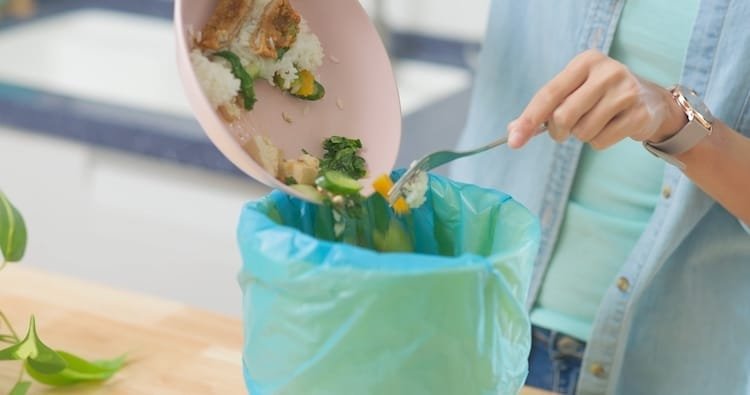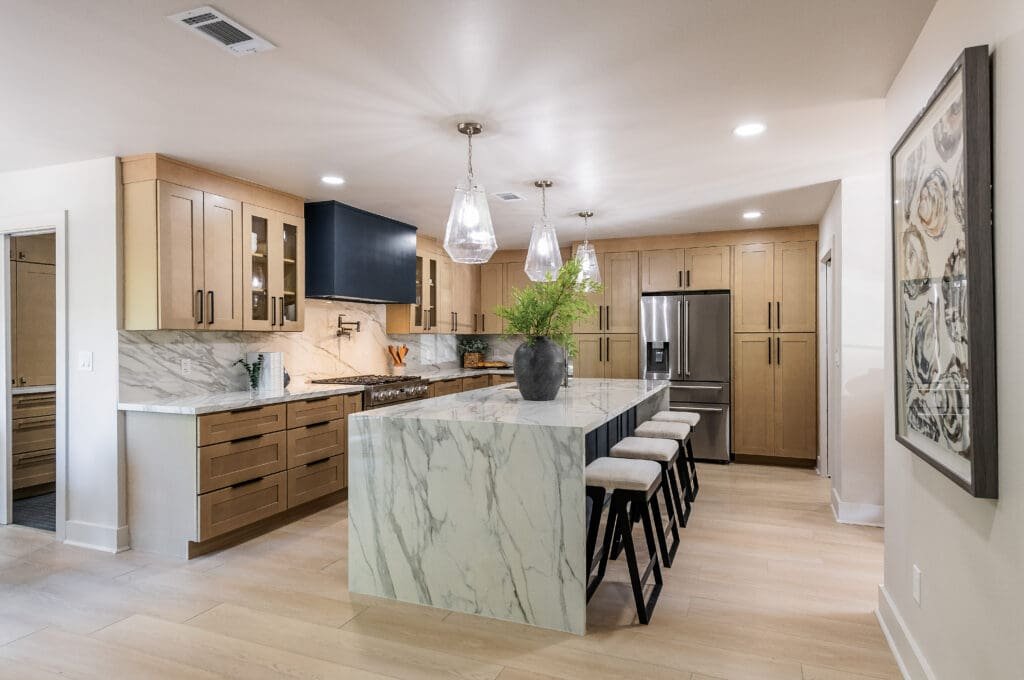
Eco-friendly kitchen design isn’t just about style — it’s about making smarter choices for our planet and your home. In this post, we’ll explore how to craft a kitchen that not only looks great but also operates with sustainability at its heart. From the best materials, like natural stone countertops, to energy-efficient appliances and waste-reduction strategies, we’ll cover all you need to know to make your kitchen environmentally friendly and stunningly beautiful. Ready to create a space that’s as good for the Earth as it is for your culinary interests? Let’s get started.
Understanding Eco-Friendly Kitchen Design
What exactly do we mean by an “eco-friendly kitchen design”? At its core, this concept focuses on creating a space that minimizes environmental impact through efficient energy use, sustainable material selection, and designs that promote long-term sustainability. The goal is not just to reduce your carbon footprint but also to enhance your kitchen’s functionality and aesthetic appeal in practical and sustainable ways.
An eco-friendly kitchen design prioritizes efficient energy use. This could mean installing appliances that use less electricity, incorporating LED lighting to reduce energy consumption, or designing the space to maximize natural light during the day to cut down on electric use. Each element works together to decrease your home’s overall energy demands.
Choosing the right materials is also crucial in eco-friendly kitchen design. Sustainable materials are either sourced in a way that has a low environmental impact or are made from recycled components. For instance, using reclaimed wood for cabinets or choosing countertops made from recycled glass or sustainably sourced natural stone can make a significant difference in your kitchen’s environmental footprint.
Lastly, sustainability also means selecting materials and designs that will stand the test of time and not need frequent replacement. This reduces waste and the demand for new resources. For example, choosing high-quality fixtures and fittings that won’t need to be replaced often can be more sustainable in the long run.
Incorporating these elements into your kitchen isn’t just about making eco-friendly choices; it’s about creating a space that aligns with your values and lifestyle. By understanding the principles behind eco-friendly kitchen design, you can make informed decisions that lead to a greener, more efficient home.
Energy Efficiency in the Kitchen

Energy efficiency is at the heart of an eco-friendly kitchen design. By integrating energy-saving appliances, making the most of natural light, and choosing efficient lighting options, you can create a space that’s both functional and kind to the planet. Let’s dive into some practical ways to boost your kitchen’s energy efficiency.
Energy-Efficient Appliances
Switching to energy-efficient appliances is one of the easiest and most impactful changes you can make. When shopping for new appliances, keep an eye out for the Energy Star label. This label means the product meets strict energy efficiency guidelines set by the US Environmental Protection Agency. Here are some key appliances to consider:
- Refrigerators: Energy Star-rated refrigerators are at least 15% more efficient than the federal efficiency standard. Look for features like improved insulation, high-efficiency compressors, and advanced temperature controls that help keep your food fresh while saving energy.
- Dishwashers: Modern dishwashers are designed to be water and energy efficient. Models with soil sensors adjust the water usage based on how dirty the dishes are, while eco-wash settings use lower temperatures and shorter cycles to conserve energy.
- Ovens and stoves: Induction cooktops are a fantastic option, as they heat food directly using electromagnetic energy, reducing wasted heat. You can even upgrade to an Invisicook surface for an ultra-modern induction cooktop solution. For ovens, consider models with advanced insulation and convection features, which cook food faster and more evenly, saving you both time and energy.
Natural Lighting
Making the most of natural light not only reduces your reliance on artificial lighting but also creates a bright and welcoming kitchen space. Here are some ways to enhance natural lighting in your kitchen.
- Windows: Installing large windows can flood your kitchen with sunlight, cutting down on the need for electric lighting during the day. Positioning windows on multiple walls allows light to enter from different angles, ensuring even levels of natural sunlight.
- Skylights: Skylights are an excellent way to bring more natural light into your kitchen, especially in spaces where wall windows aren’t an option. Skylights can also provide natural ventilation, offering another opportunity for eco-friendliness on warm days,
- Light tubes: Also known as solar tubes, these devices capture sunlight on your roof and channel it into your kitchen through a reflective tube. They’re perfect for brightening up interior spaces that lack direct window access.
LED Lighting
When the sun goes down, LED lighting is your best friend. LED bulbs are incredibly energy-efficient, using up to 75% less energy and lasting up to 25 times longer than traditional incandescent bulbs. Here’s how to effectively bring LED lighting into your kitchen.
- Task lighting: Install LED under-cabinet lights to illuminate your countertops and work areas. This focused lighting improves visibility for cooking and other tasks, reducing the need for overhead lights.
- Ambient lighting: Use LED ceiling fixtures or recessed lights to provide overall lighting. Adding dimmer switches allows you to adjust the brightness to suit your needs, saving even more energy.
- Accent Lighting: Why not try highlighting features like kitchen islands, artwork, or other architectural details with LED strip lights or spotlights?
Sustainable Materials for Kitchen Design
Choosing the right materials is also an important part of creating an eco-friendly kitchen. Sustainable materials not only reduce environmental impact but also enhance the beauty and durability of your kitchen. Let’s explore some excellent options for eco-friendly kitchen countertops, cabinets, flooring, and finishes.
Countertops play a big role in the overall look and functionality of your kitchen, so opting for eco-friendly materials can make a big difference. Recycled glass countertops are an excellent choice, made from crushed glass combined with a resin binder. These countertops are not only visually striking but also environmentally friendly, as they make use of post-consumer and industrial glass waste. They come in a wide range of colors and patterns, adding a unique touch to your kitchen. If you prefer natural stone, choose sustainable options like granite and marble. These can be eco-friendly if sourced responsibly. For example, here at Granite and Marble Solutions, we prioritize sourcing materials to reduce transportation emissions. Natural stone is durable and long-lasting, which means it won’t need to be replaced often, reducing waste over time. Another great option is bamboo. As a rapidly renewable resource, bamboo grows much faster than traditional hardwoods. Bamboo countertops are sturdy, resistant to stains, and have a unique, natural look, making them an excellent choice for a sustainable kitchen design.
The materials you choose for your cabinets and flooring can also impact your kitchen’s sustainability. Reclaimed wood is an excellent option for both cabinets and flooring, giving new life to old materials. This reduces the demand for new timber and prevents usable wood from ending up in landfills. Reclaimed wood has a rustic charm and unique character, making it a stylish and sustainable choice. Both bamboo and cork are fantastic choices for eco-friendly flooring. Bamboo grows quickly and regenerates without needing to be replanted, making it a sustainable alternative to traditional hardwood. Cork is harvested from the bark of cork oak trees, which can be stripped without harming the tree. It’s resilient, comfortable underfoot, and has natural insulating properties. If you do use new wood, look for products certified by the Forest Stewardship Council (FSC). This certification ensures the wood is sourced from responsibly managed forests that provide environmental, social, and economic benefits.
The paints and finishes you choose can also impact indoor air quality and overall health. Opting for low-VOC (volatile organic compounds) or zero-VOC products is a healthier choice for your home and the environment. Traditional paints can release harmful chemicals into the air, affecting indoor air quality. Low-VOC and zero-VOC paints emit fewer pollutants, making them a safer choice for your kitchen. These paints are available in a wide variety of colors and finishes, so you don’t have to sacrifice style for sustainability. Natural oil finishes for wood surfaces, such as tung oil, linseed oil, and beeswax, are non-toxic and environmentally friendly. They provide a durable, protective coating while enhancing the natural beauty of wood. Water-based finishes are another eco-friendly option. They contain fewer harmful solvents compared to oil-based finishes and dry quickly, reducing the overall environmental impact.
To summarize, here are some sustainable material options to consider for your kitchen:
- Countertops: Recycled glass, sustainably sourced natural stone, bamboo
- Cabinets: Reclaimed wood, FSC-certified wood
- Flooring: Bamboo, cork, reclaimed wood
- Paints and Finishes: Low-VOC or zero-VOC paints, natural oil finishes, water-based finishes
By choosing sustainable materials for your countertops, cabinets, flooring, and finishes, you can create a beautiful and eco-friendly kitchen. These materials not only minimize environmental impact but also offer durability and style, ensuring your kitchen stands the test of time. Embracing these options allows you to enjoy a space that reflects your commitment to sustainability while providing a functional and attractive environment for your culinary adventures.
Water Conservation
Water conservation is a part of eco-friendliness that’s not talked about as often when it comes to home design. However, by implementing smart water-saving strategies, you can reduce your water usage, lower your utility bills, and contribute to the preservation of this resource.
One of the simplest ways to save water is by upgrading to efficient faucets and fixtures. Low-flow faucets, for instance, reduce the flow rate of water without compromising performance. While a standard kitchen faucet flows at about 2.2 gallons per minute (GPM), low-flow models reduce this to 1.5 GPM or less. What’s more, installing aerators on your existing faucets can help conserve water by mixing air with the water stream, reducing the flow rate while maintaining pressure. Hands-free, sensor-activated faucets can also prevent water wastage by automatically shutting off when not in use, ensuring water only flows when needed.
As we mentioned when discussing energy efficiency, modern dishwashers are another great way to save water. Remember, when shopping for a new dishwasher, look for:
- The Energy Star label
- Soil sensors to detect the level of dirt on your clothes
- Eco-wash settings
- Water recycling systems.
Practical habits in the kitchen can also make a big difference in water conservation. Fixing leaks promptly is a great place to start, as even small leaks can lead to significant water waste over time. When washing fruits, vegetables, or dishes by hand, fill a basin with water instead of letting the tap run continuously. This method uses much less water. Finally, always run your dishwasher with a full load to maximize water efficiency. The same principle applies to washing machines if you do laundry in your kitchen.
Consider composting food scraps instead of using a garbage disposal, which requires a lot of water to process food waste. Composting not only conserves water but also provides you with nutrient-rich compost for your garden. If you prefer cold drinking water, keep a pitcher in the refrigerator instead of running the tap until the water gets cold. This ensures you always have cold water without wasting any.
Lastly, installing a water filter can reduce the need for bottled water, which not only saves money but also reduces plastic waste. By encouraging you to drink more tap water, a filter can make your kitchen both more economical and eco-friendly.
Waste Reduction and Recycling

Reducing waste and recycling are simple ways to make your kitchen more eco-friendly. By minimizing waste, recycling effectively, and composting organic materials, you can significantly lower your kitchen’s environmental impact. Here’s how you can incorporate waste reduction and recycling into your kitchen design and daily routines.
Composting in the Kitchen
Composting is a fantastic way to reduce food waste and create nutrient-rich soil for your garden. Setting up a composting system in your kitchen is easier than you might think. Start by designating a small bin or container with a lid to collect food scraps. — you can keep this container under the sink or on your countertop for easy access. Good compost materials include fruit and vegetable peels, coffee grounds, eggshells, and even paper towels. Avoid composting meat, dairy, and oily foods, as these can attract pests and create odors.
Once your kitchen bin is full, transfer the scraps to an outdoor compost pile or a larger compost bin. Over time, these organic materials will break down into rich, fertile compost that you can use to nourish your plants. Not only does composting reduce the amount of waste sent to landfills, but it also returns valuable nutrients to the soil, promoting a healthy and sustainable garden.
Creating a Recycling Area
Setting up a dedicated recycling area in your kitchen makes it easy to sort and manage recyclables. Choose a convenient location, such as a corner of your kitchen or a cabinet near your waste bin. Use separate bins for different types of recyclables, such as paper, plastics, metals, and glass. Label each bin clearly to ensure proper sorting. Having a well-organized recycling area encourages everyone in your household to participate in recycling and makes it more convenient to transport items to your local recycling facility.
Reducing Single-Use Items
Single-use items, such as plastic wrap, bags, and disposable containers, contribute a great deal to kitchen waste. Fortunately, there are many sustainable alternatives available. Replace plastic wrap with reusable beeswax wraps, which can be used to cover bowls, wrap sandwiches, and store food. Swap out plastic bags for reusable silicone or cloth bags, and invest in a set of glass or stainless steel containers for food storage, which are durable and can be used for years.
Smart Shopping and Food Storage
Being mindful of your shopping and food storage habits can also help reduce waste. Plan your meals for the week and create a shopping list to avoid buying unnecessary items — this reduces the likelihood of food going to waste. When storing food, use clear containers to easily see what you have and avoid forgotten leftovers. Implementing a “first in, first out” system ensures older food items are used before newer ones, reducing spoilage and waste.
Creativity and Upcycling
Finding creative ways to reuse and upcycle items in your kitchen can further be a fun way to waste. Glass jars from sauces and jams can be cleaned and repurposed for storing dry goods, such as rice, pasta, or spices. Old dish towels can be cut into smaller pieces and used as cleaning rags. Even seemingly useless items can find a new purpose with a little creativity. Get your whole family involved and see what useful or beautiful items you can make with unwanted kitchen items.
Donation and Repurposing
Before discarding items that are still in good condition, you should always consider donating them. Kitchen utensils, appliances, and cookware can often be donated to local charities or shelters, so check for drop-off points in your area before you resort to throwing anything in the trash.
Transform Your Kitchen with Eco-Friendly Countertops
Ready to take the next step in creating your eco-friendly kitchen? Talk to Granite and Marble Solutions about our natural stone countertops. Our commitment to quality and sustainability makes us the ideal partner for your kitchen remodel. Our team is ready to work with you to explore beautiful and eco-friendly countertop options that align with your values while adding warmth and elegance to your home.
Transform your kitchen into a space that’s not only functional and stylish but also kind to the environment. Contact Granite and Marble Solutions today to start your journey towards a more sustainable and beautiful kitchen.



